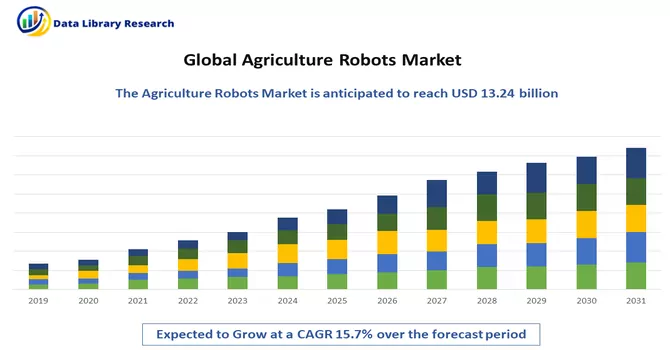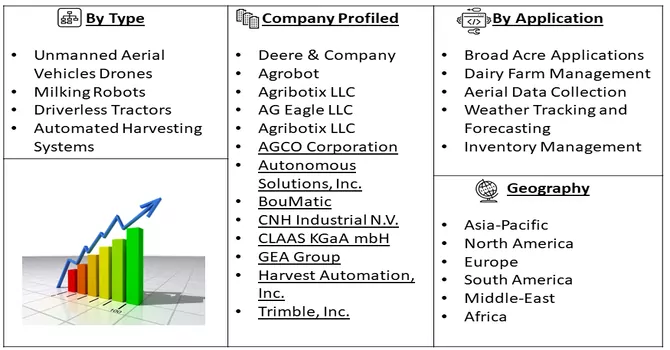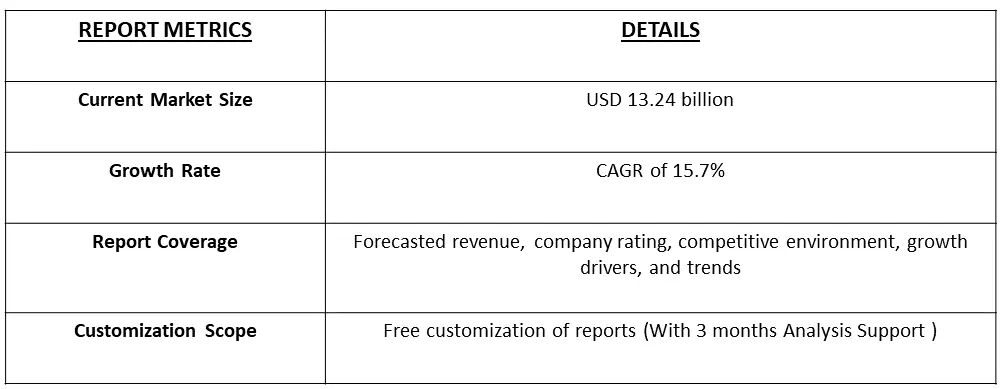The Agricultural Robots Market is currently valued at USD 13.24 billion in 2023, growing at a CAGR of 15.7% during the forecast period (2023-2030).

Get Complete Analysis Of The Report - Download Free Sample PDF
An agriculture robot, also known as an agri-robot or AG-bot, is a specialized robotic system or device designed and employed in agricultural applications to perform various tasks related to crop cultivation, livestock management, and farm operations. These robots are equipped with sensors, actuators, and often advanced technologies like artificial intelligence, computer vision, and GPS to automate and assist with a wide range of agricultural activities. Agriculture robots can be used for tasks such as planting, seeding, weeding, harvesting, crop monitoring, irrigation management, pest control, and data collection. They are utilized to enhance agricultural efficiency, reduce labor costs, optimize resource usage, and promote sustainable and precision farming practices.
Agricultural robots, often referred to as AGRIbots, represent a recent transformative development in the agriculture sector. These autonomous machines have been harnessed to enhance crop quality, improve yield efficiency, increase overall agricultural productivity, and reduce dependency on manual labor. In light of the increasing global population and the escalating demand for food, farmers are embracing modern technologies and equipment, including agricultural robots, as a means to elevate their overall productivity and revenue generation.
Agriculture robots are becoming more sophisticated and capable due to advancements in AI, machine learning, computer vision, and sensor technologies. These robots can perform tasks such as planting, harvesting, weeding, and monitoring crops with higher precision and efficiency. The agriculture robot market is witnessing significant growth and innovation driven by the need for sustainable and efficient farming practices. As technology continues to advance and agriculture becomes increasingly data-driven, the role of robotics in modern farming is expected to expand, addressing the challenges of feeding a growing global population while optimizing resource utilization and reducing environmental impact.
Market Segmentation:
The Global Agriculture Robots Market is Segmented by Type (Unmanned Aerial Vehicles (Drones), Milking Robots, Driverless Tractors, and Automated Harvesting Systems), Application (Broad Acre Applications, Dairy Farm Management, Aerial Data Collection, Weather Tracking and Forecasting, and Inventory Management), Offering (Hardware, Software, and Services), and Geography (North America, Europe, Asia-Pacific, South America, and Africa). The report offers market size and forecasts in value (in USD million) for all the above segments.

For Detailed Market Segmentation - Download Free Sample PDF
Market Drivers:
Increased Efficiency and Productivity and an Increased Demand for Food
The demand for food continues to rise in tandem with the global population, and the role of agriculture robots is becoming increasingly pivotal. They are not just tools for modernization but a necessity for ensuring food security and meeting the challenges posed by climate change and labor shortages. Thus, agriculture robots have positioned themselves as a driving force in the quest for increased efficiency and productivity in farming. Their remarkable precision, tireless work ethic and potential for resource optimization make them indispensable tools for the agriculture industry. As they continue to evolve and integrate advanced technologies, agriculture robots are poised to play an even greater role in meeting the rising global demand for food and shaping the future of agriculture.
Agriculture Robots Market Technological Advancements
The agricultural landscape is undergoing a profound transformation, driven by remarkable advancements in technology. AI and machine learning play a pivotal role in agriculture robots. They enable these machines to analyze data, recognize patterns, and make decisions in real time. For instance, AI allows robots to distinguish between crops and weeds for precise weeding. Agriculture robots are equipped with a suite of sensors that capture data on soil health, crop conditions, and environmental factors. These data points are instrumental in making data-driven decisions for planting, fertilizing, and pest control. Thus, owing to such advantages, the market is expected to witness significant growth over the forecast period.
Market Restraints :
Agriculture Robots Market Regulatory Hurdles in Using AgriBots
The use of agribots in farming is subject to a complex and evolving regulatory landscape. Agriculture is one of the most regulated industries in many countries, and introducing autonomous robots into this sector introduces new challenges and considerations. Some agribots are designed for remote operation, which raises concerns about the security of these machines. Unauthorized access to agribots can result in tampering or data breaches, necessitating regulatory oversight. Thus, the growth of the market is expected to slow down over the forecast period.
In 2020, the pandemic disrupted global supply chains, affecting the production and distribution of agriculture robots and their components. This led to delays and shortages in the market. In the current scenario, the COVID-19 pandemic on the agriculture robot market is likely to be positive overall. The increased emphasis on automation, precision agriculture, and sustainability aligns with the capabilities of agriculture robots. As technology continues to advance, and as farmers seek to reduce their reliance on manual labor and improve operational resilience, the demand for agriculture robots is expected to grow.
Segmental Analysis :
Milking Robots Segment is Expected to Witness Significant Growth Over the Forecast Period
Milking robots reduce the need for manual labor in the milking process. This allows farmers to allocate their time and resources more efficiently. Milking robots represent the future of dairy farming, offering sustainable and animal-friendly solutions. As technology continues to advance, these systems are likely to become more efficient and cost-effective. Their ability to combine automation, data-driven decision-making, and improved animal welfare positions them at the forefront of modern agriculture, ensuring a promising future for the dairy industry. Thus, the segment is expected to witness significant growth over the forecast period.
Weather Tracking and Forecasting Segment is Expected to Witness Significant Growth Over the Forecast Period
Weather plays a pivotal role in agriculture, influencing decisions related to planting, harvesting, irrigation, and pest management. With the advent of agriculture robots, the integration of accurate weather tracking and forecasting has become increasingly essential for optimizing farm operations and crop yields. Here, we delve into the synergy between weather data and agriculture robots and how this collaboration is transforming modern farming. Agriculture robots collect real-time data on crop health and soil conditions. By integrating local weather data, these robots can make data-driven decisions on when and where to irrigate, apply fertilizers, or implement pest control measures. Thus, the segment is expected to witness significant growth over the forecast period.
Software Segment is Expected to Witness Significant Growth Over the Forecast Period
Agriculture robots, or Agri-bots, rely on a combination of hardware and software to perform their tasks. While the hardware components include sensors, actuators, cameras, and robotic arms, it is the software that acts as the central intelligence, orchestrating the robot's movements and decision-making processes. The integration of artificial intelligence (AI) and machine learning is a core aspect of software in agriculture robots. These technologies allow robots to identify and differentiate between crops and weeds, detect pests and diseases, and make informed decisions based on patterns and historical data. Thus, the segment is expected to witness significant growth over the forecast period.
North America Segment is Expected to Witness Significant Growth Over the Forecast Period
North America holds the dominant position in the agricultural robots market, primarily driven by several key factors. The region's market leadership can be attributed to the widespread adoption of advanced technology, which is a response to labor shortages, high labor costs, and a relatively high per-capita disposable income. One of the driving forces behind the market's growth in North America is the encouragement and support from government bodies for the deployment of agricultural robots. These include unmanned aerial vehicles, driverless tractors, and various other smart farming systems. Such initiatives have significantly contributed to the expansion of the agricultural robot market in the region.
To further enhance crop yields and reduce operational costs for farmers, numerous players in this market have made substantial investments in the development of cost-efficient and highly productive robots. For example, in 2021, Santa Monica-based company Future Acres introduced its groundbreaking robot, Carry, designed specifically for grape picking. Carry utilizes artificial intelligence (AI) to assist in the transportation of hand-picked crops, working in conjunction with human labor. This innovation not only addresses the challenges posed by labor shortages but also introduces new, farmer-centric products to the market.
Thus, North America's prominence in the agricultural robots market is a result of various factors, including technological adoption, government support, and strategic investments by industry players. The introduction of innovative solutions, like Future Acres' Carry, exemplifies the region's commitment to overcoming challenges in farming and driving growth in the agricultural robots sector.

Get Complete Analysis Of The Report - Download Free Sample PDF
The agricultural robot market is consolidated with active players competing on the basis of product quality and promotion and focusing on their strategic moves to hold larger market shares. Companies are investing heavily to develop new and cost-efficient products. They are also collaborating with and acquiring other companies to increase their market shares and strengthen R&D activities. Some of the major players in the agricultural robots market are:
Recent Developments:
1) June 2022: Small Robot Company (SRC), a British agriculture robotics startup, announced plans to launch its agricultural robots at around 50 farms over the course of the 2022-2023 growing season.
2) February 2022: Verdant Robotics launched its robot-as-a-service (RaaS) model to ensure access for more specialty crop farmers to meet their demands for more sustainable and profitable growing practices.
Q1. What is the current Agriculture Robots Market size?
The Agricultural Robots Market is currently valued at USD 13.24 billion.
Q2. What is the Growth Rate of the Agricultural Robots Market?
Agricultural Robots Market growing at a CAGR of 15.7% during the forecast period.
Q3. What segments are covered in the Agricultural Robots Market Report?
By Type, By Offering, By Application & Geography these segments are covered in the Agricultural Robots Market Report
Q4. What are the factors driving the Agricultural Robots Market ?
Key factors that are driving the growth include the
Data Library Research are conducted by industry experts who offer insight on industry structure, market segmentations technology assessment and competitive landscape (CL), and penetration, as well as on emerging trends. Their analysis is based on primary interviews (~ 80%) and secondary research (~ 20%) as well as years of professional expertise in their respective industries. Adding to this, by analysing historical trends and current market positions, our analysts predict where the market will be headed for the next five years. Furthermore, the varying trends of segment & categories geographically presented are also studied and the estimated based on the primary & secondary research.
In this particular report from the supply side Data Library Research has conducted primary surveys (interviews) with the key level executives (VP, CEO’s, Marketing Director, Business Development Manager and SOFT) of the companies that active & prominent as well as the midsized organization
FIGURE 1: DLR RESEARH PROCESS

Extensive primary research was conducted to gain a deeper insight of the market and industry performance. The analysis is based on both primary and secondary research as well as years of professional expertise in the respective industries.
In addition to analysing current and historical trends, our analysts predict where the market is headed over the next five years.
It varies by segment for these categories geographically presented in the list of market tables. Speaking about this particular report we have conducted primary surveys (interviews) with the key level executives (VP, CEO’s, Marketing Director, Business Development Manager and many more) of the major players active in the market.
Secondary ResearchSecondary research was mainly used to collect and identify information useful for the extensive, technical, market-oriented, and Friend’s study of the Global Extra Neutral Alcohol. It was also used to obtain key information about major players, market classification and segmentation according to the industry trends, geographical markets, and developments related to the market and technology perspectives. For this study, analysts have gathered information from various credible sources, such as annual reports, sec filings, journals, white papers, SOFT presentations, and company web sites.
Market Size EstimationBoth, top-down and bottom-up approaches were used to estimate and validate the size of the Global market and to estimate the size of various other dependent submarkets in the overall Extra Neutral Alcohol. The key players in the market were identified through secondary research and their market contributions in the respective geographies were determined through primary and secondary research.
Forecast Model
